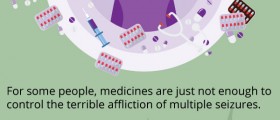
Benign rolandic epilepsy represents an epilepsy syndrome and is characterized by seizures that most commonly affect the face and sometimes the body. The condition is also known under the names benign rolandic epilepsy of childhood and benign epilepsy with centro-temporal spikes.
What Means Benign?
The term benign is quite suitable because it points to the positive outcome of the disease. Namely, unlike other types of epilepsy which, once they occur, stay for the rest of someone's life, benign rolandic epilepsy is only a temporary condition and is eventually overgrown.
In children suffering from benign rolandic epilepsy the seizures originate from the rolandic area of the brain. Majority of patients have no additional problems (such as learning difficulties).
Benign Rolandic Epilepsy Clinical Characteristics
It is common for patients suffering from benign rolandic epilepsy to develop seizures as they wake up in the morning. Most of them report tingling on one side of the mouth. The peculiar sensation may affect the tongue, lips, gum and inner side of the cheek.
Furthermore, seizures can also affect the throat, resulting in speech problems. The affected child simply cannot talk and only makes strange throaty or gurgling noises.
Another characteristic of benign rolandic epilepsy is twitching and stiffness of one side of the face. In some individuals such problems may further spread and affect the ipsilateral arm or leg.
Rarely, both sides are equally affected. In such case the child most frequently loses consciousness and there are regular jerking movements of the upper and lower extremities. The attack may be accompanied by incontinence. This progression into tonic-clonic seizures is not so frequent. After the attack the child feels exhausted and may sleep for a few hours.
Diagnosing Benign Rolandic Epilepsy
Doctors evaluate patient's medical history and perform certain tests and exams out of which the most significant one is electroencephalogram (EEG). This test can confirm the presence of seizures and their precise location. Normal result after performing EEG does not exclude the condition.
Benign Rolandic Epilepsy Treatment
Even though some children may need to be treated with anti-epileptic drugs, most of them do not require any treatment at all. For instance, children who have had only a couple of attacks and in whom seizures have not repeated do not need to take medications. As it has already been mentioned the condition withdraws spontaneously once the child enters puberty.
Still, many parents feel more secure if their child is prescribed with some anti-epileptic drugs. The most commonly prescribed medications for this purpose include carbamazepine, lamotrigine and sodium valproate.

















Your thoughts on this
Loading...